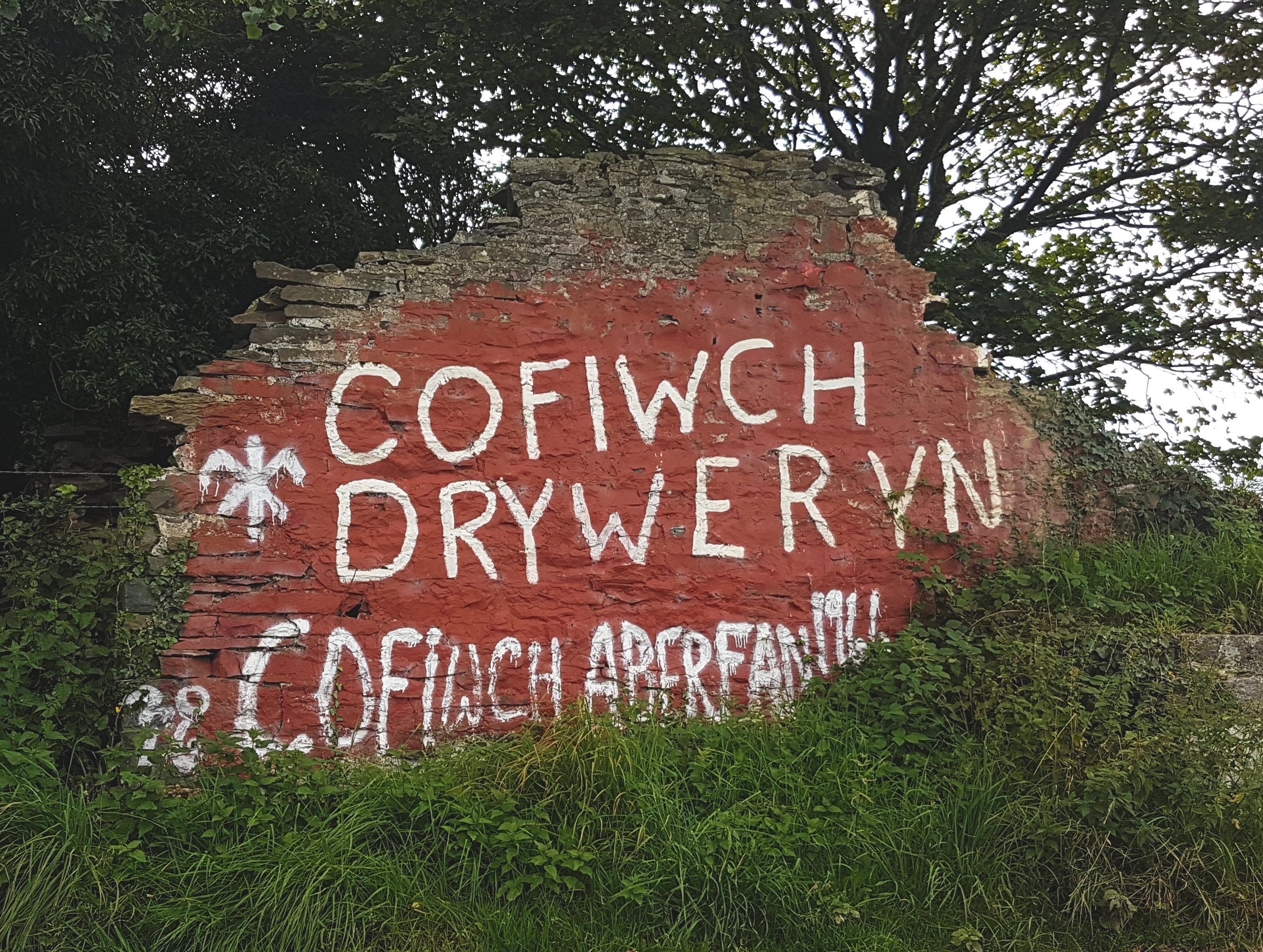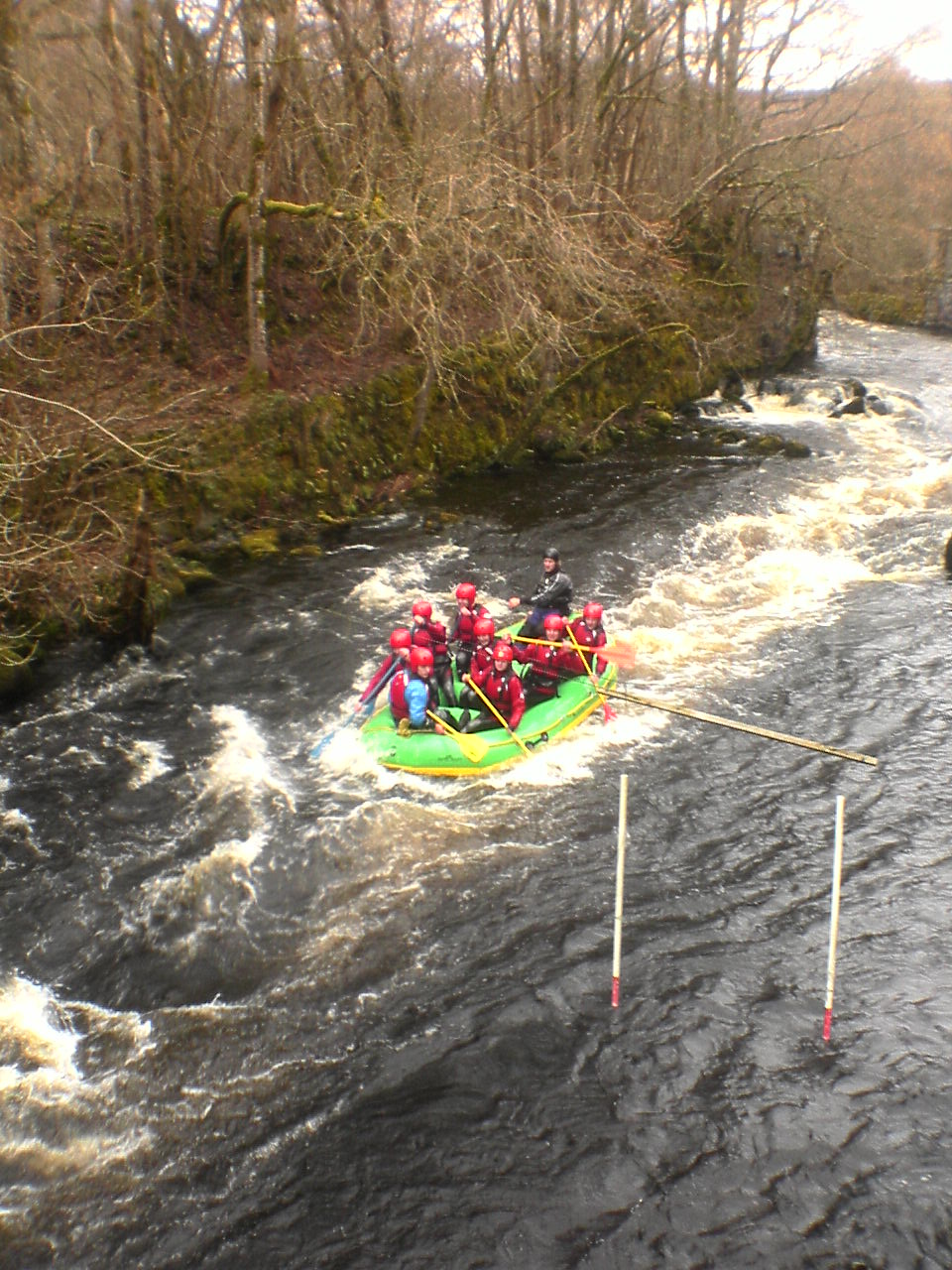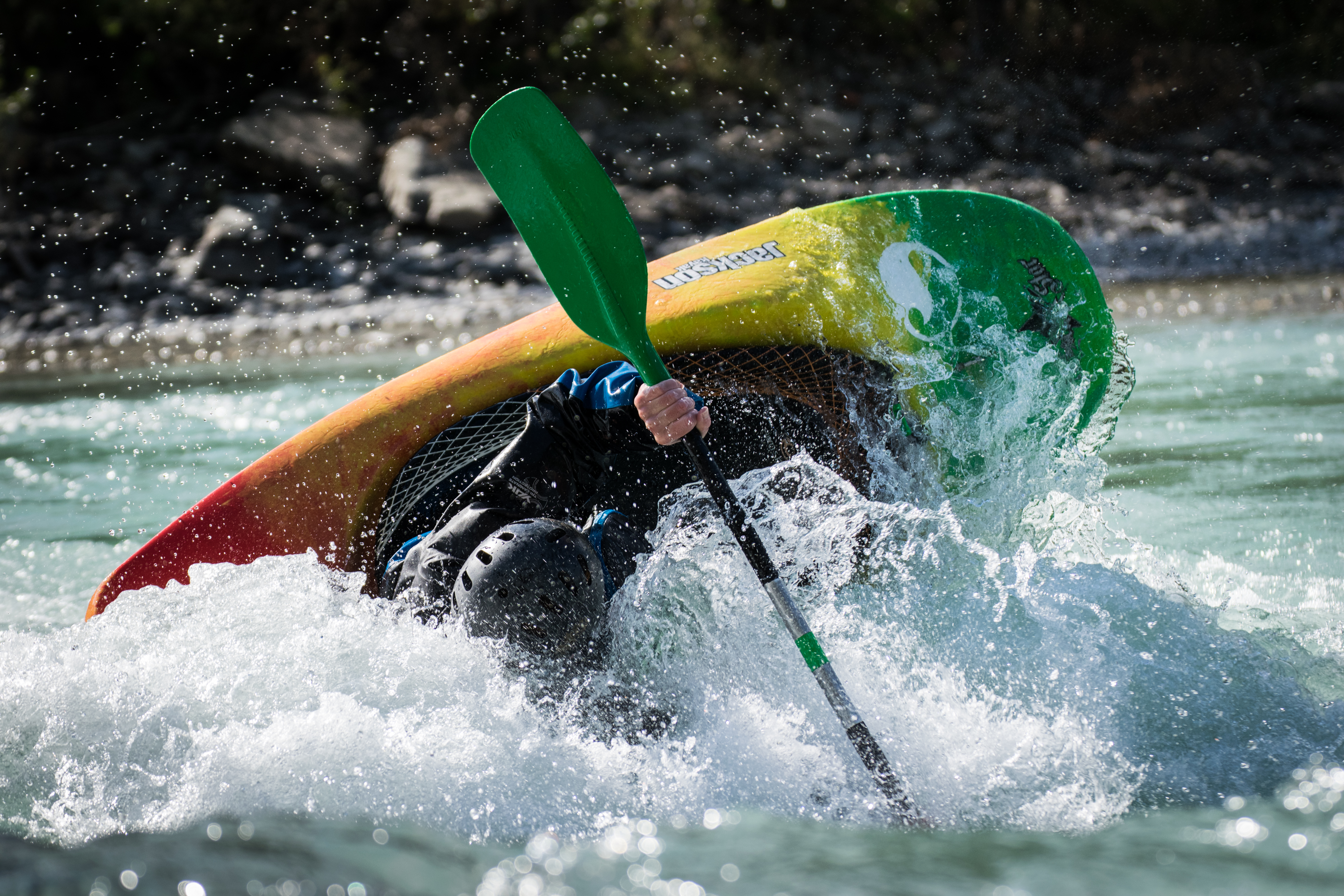|
Tryweryn
The Tryweryn is a river in the north of Wales which starts at Llyn Tryweryn in the Snowdonia National Park and after joins the river Dee at Bala. One of the main tributaries of the Dee, it was dammed in 1965 to form Llyn Celyn, drowning the village of Capel Celyn in spite of much popular and political opposition in Wales. The resulting graffiti "Cofiwch Dryweryn" ("Remember Tryweryn") near Llanrhystud became and remains a popular icon of Welsh feeling. Water is stored in Llyn Celyn in winter when flows are high, and released over the summer to maintain the flow in the Dee (water from the Dee is used as the water supply for large areas of north-east Wales, and for the Wirral and much of Liverpool in England. Whitewater sports The Tryweryn River joins the River Dee roughly half a mile downstream from llyn Tegid. The reservoir now at the head of the Tryweryn was created in 1965, to provide water to Liverpool. At that time, the 67 inhabitants of the village of Capel Celyn wer ... [...More Info...] [...Related Items...] OR: [Wikipedia] [Google] [Baidu] |
Cofiwch Dryweryn
(English: "Remember Tryweryn") or (English: "The Remember Tryweryn Wall") is a graffitied stone wall near Llanrhystud, Ceredigion, Wales. Author and journalist Meic Stephens originally painted the words onto the wall of a ruined cottage in the early 1960s following the decision by the Liverpool City Council to flood the Tryweryn Valley, including the community of Capel Celyn to create the Llyn Celyn reservoir. Due to its prominent location, stark message, and history of repeated vandalism, the wall has become an unofficial landmark of mid Wales. The phrase "" has itself become a prominent political slogan for Welsh nationalism, appearing on T-shirts and banners, and as replica murals. History Background In July 1957, following parliamentary approval, Liverpool City Council pursued the flooding of the Tryweryn Valley without the consent of Welsh authorities and against the wishes of most Welsh Members of Parliament. The council also failed to respond to formal planning inqui ... [...More Info...] [...Related Items...] OR: [Wikipedia] [Google] [Baidu] |
Llyn Celyn
Llyn Celyn () is a reservoir constructed between 1960 and 1965 in the valley of the River Tryweryn in Gwynedd, Wales. It measures roughly long by wide, and has a maximum depth of . It has the capacity to hold of water. It was originally to be named ''Llyn Tryweryn Mawr'' (meaning "great Tryweryn lake"), but in September 1964 Liverpool Corporation agreed to the name change following a letter from the Tryweryn Defence Committee. Construction and opposition Construction of the reservoir for Liverpool Corporation Waterworks involved flooding the village of Capel Celyn and adjacent farmland, a deeply controversial move. Much of the opposition was brought about because the village was a stronghold of Welsh culture and the Welsh language, whilst the reservoir was being built to supply water to Liverpool and parts of the Wirral peninsula, rather than Wales. Liverpool Corporation's Tryweryn Reservoir Bill was presented in Parliament as a private bill in January 1957; by obtain ... [...More Info...] [...Related Items...] OR: [Wikipedia] [Google] [Baidu] |
Canolfan Tryweryn
Canolfan Tryweryn is the National White Water Centre for Wales, and is based near Bala in north Wales. It developed the first commercial white water rafting operation in the UK in 1986, and since then has grown to become the largest and one of the most well-known rafting organisations in the UK. The centre is home to paddlesport National Governing Body Canoe Wales. The National White Water Centre is ideal for canoeing, kayaking, play-boating and coached groups who sometimes run BCU/ CW Star Awards. The River Tryweryn The Tryweryn is a river in north Wales. It flows from Llyn Celyn in the Snowdonia National Park and after 19 km (12 miles) joins the river Dee at Bala. It is one of the main tributaries of the Dee and has been dammed to form Llyn Celyn. Water is stored in winter when flows are high, and released over the summer to maintain the flow in the Dee, meaning that the river often has suitable water levels for kayakers and rafters at time of year when nat ... [...More Info...] [...Related Items...] OR: [Wikipedia] [Google] [Baidu] |
Welsh Canoe Association
Canoe Wales ( cy, Canŵ Cymru) is the national governing body for paddlesport in Wales. It covers all branches of the sport from recreational canoeing, kayaking, stand up paddleboarding and rafting to whitewater racing, slalom racing and wildwater racing; flatwater sprint racing and marathon racing; canoe sailing; canoe polo; surf kayaking and canoeing; and extreme racing. The organisation has over 2,700 members including individual paddlers as well as affiliated club members. Full adult members of Canoe Wales are also by default Welsh members of British Canoeing. Canoe Wales' vision is to create an "inclusive and active paddling community in Wales" and its mission is "to inspire and support more people across Wales to go paddling". History Formerly known as the Welsh Canoeing Association, it was in the past responsible for the formal access agreements on the Conwy, Glaslyn, Llwyd, Ogwr, Severn, Tawe, Tryweryn, Twrch, Usk and Wye and informal agreements on rivers and man ... [...More Info...] [...Related Items...] OR: [Wikipedia] [Google] [Baidu] |
Wales
Wales ( cy, Cymru ) is a Countries of the United Kingdom, country that is part of the United Kingdom. It is bordered by England to the Wales–England border, east, the Irish Sea to the north and west, the Celtic Sea to the south west and the Bristol Channel to the south. It had a population in 2021 of 3,107,500 and has a total area of . Wales has over of coastline and is largely mountainous with its higher peaks in the north and central areas, including Snowdon (), its highest summit. The country lies within the Temperateness, north temperate zone and has a changeable, maritime climate. The capital and largest city is Cardiff. Welsh national identity emerged among the Celtic Britons after the Roman withdrawal from Britain in the 5th century, and Wales was formed as a Kingdom of Wales, kingdom under Gruffydd ap Llywelyn in 1055. Wales is regarded as one of the Celtic nations. The Conquest of Wales by Edward I, conquest of Wales by Edward I of England was completed by 1283, th ... [...More Info...] [...Related Items...] OR: [Wikipedia] [Google] [Baidu] |
Capel Celyn
Capel Celyn was a rural community to the northwest of Bala in Gwynedd, Wales, in the Afon Tryweryn valley. The village and other parts of the valley were flooded in 1965 to create a reservoir, Llyn Celyn, in order to supply Liverpool and Wirral with water for industry. At the time the village was one of the few remaining that were Welsh speaking. The flooding of the village was controversial as Liverpool City Council did not require planning consent from the local Welsh authorities as the reservoir was approved via an Act of Parliament. As a consequence there was no local debate on the proposal. Etymology is Welsh Welsh may refer to: Related to Wales * Welsh, referring or related to Wales * Welsh language, a Brittonic Celtic language spoken in Wales * Welsh people People * Welsh (surname) * Sometimes used as a synonym for the ancient Britons (Celtic peop ... for chapel, while is Welsh for holly. Flooding When the valley was flooded in 1965, the village and its buil ... [...More Info...] [...Related Items...] OR: [Wikipedia] [Google] [Baidu] |
River Dee, Wales
The River Dee ( cy, Afon Dyfrdwy, la, Deva Fluvius) is a river in the United Kingdom. It flows through parts of both Wales and England, forming part of the border between the two countries. The river rises in Snowdonia, Wales, flows east via Chester, England, and discharges to the sea in an estuary between Wales and the Wirral Peninsula in England. It has a total length of . History The River Dee was the traditional boundary of the Kingdom of Gwynedd in Wales for centuries, possibly since its founding in the 5th century. It was recorded in the 13th century (in mainstream Middle English orthography, lacking the letters v and w) as ''flumen Dubr Duiu''; the name appears to derive from the Brythonic ''dēvā'': "River of the Goddess" or "Holy River". The river is personified as the war and fate goddess Aerfen. The river name inspired the name of Roman fortress ''Deva Victrix''. It is the only river in the UK to be subject to a Water Protection Zone along its whole length down ... [...More Info...] [...Related Items...] OR: [Wikipedia] [Google] [Baidu] |
Bala, Gwynedd
Bala ( cy, Y Bala) is a town and community in Gwynedd, Wales. Formerly an urban district, Bala lies in the historic county of Merionethshire, at the north end of Bala Lake ( cy, Llyn Tegid). According to the 2021 Census, Bala had a population of 1,999. 72.5 per cent of the population can speak Welsh. Toponym The Welsh word ''bala'' refers to the outflow of a lake. History The Tower of Bala ''(Welsh: Tomen y Bala)'' ( high by diameter) is a tumulus or "moat-hill", formerly thought to mark the site of a Roman camp. In the 18th century, the town was well known for the manufacture of flannel, stockings, gloves and hosiery. The large stone-built theological college, ''Coleg y Bala'', of the Calvinistic Methodists and the grammar school (now Ysgol y Berwyn), which was founded in 1712, are the chief features, together with the statue of the Rev. Thomas Charles (1755–1814), the theological writer, to whom was largely due the foundation of the British and Foreign Bible Socie ... [...More Info...] [...Related Items...] OR: [Wikipedia] [Google] [Baidu] |
River Dee (Wales)
The River Dee ( cy, Afon Dyfrdwy, la, Deva Fluvius) is a river in the United Kingdom. It flows through parts of both Wales and England, forming part of the border between the two countries. The river rises in Snowdonia, Wales, flows east via Chester, England, and discharges to the sea in an estuary between Wales and the Wirral Peninsula in England. It has a total length of . History The River Dee was the traditional boundary of the Kingdom of Gwynedd in Wales for centuries, possibly since its founding in the 5th century. It was recorded in the 13th century (in mainstream Middle English orthography, lacking the letters v and w) as ''flumen Dubr Duiu''; the name appears to derive from the Brythonic ''dēvā'': "River of the Goddess" or "Holy River". The river is personified as the war and fate goddess Aerfen. The river name inspired the name of Roman fortress ''Deva Victrix''. It is the only river in the UK to be subject to a Water Protection Zone along its whole length down ... [...More Info...] [...Related Items...] OR: [Wikipedia] [Google] [Baidu] |
Playboating
Canoe freestyle (also known as playboating) is a discipline of whitewater kayaking or canoeing where people perform various technical moves in one place (a playspot), as opposed to downriver whitewater canoeing or kayaking where the objective is to travel the length of a section of river (although whitewater paddlers will often stop and play en route). Specialised canoes or kayaks (boats) known as playboats are often used, but any boat can be used for playing. The moves and tricks are often similar to those performed by snowboarders, surfers or skaters, where the athlete completes spins, flips, turns, etc. With modern playboats it is possible to get the kayak and the paddler completely airborne while performing tricks. The competitive side of playboating is known as freestyle kayaking (formerly called rodeo). Playspots Playspots are typically stationary features on rivers, in particular standing waves (which may be breaking or partially breaking), hydraulic jumps, 'holes' and ' ... [...More Info...] [...Related Items...] OR: [Wikipedia] [Google] [Baidu] |
Llanrhystud
Llanrhystud is a seaside village and electoral division on the A487 road in the county of Ceredigion, in Wales, 9 miles (14 km) south of Aberystwyth, and 7 miles (11 km) north of Aberaeron. It takes its name from an early Welsh saint. The community includes the village of Llanddeiniol. The ''Cofiwch Dryweryn'' stone wall (English: "Remember Tryweryn") lies on the A487 a mile north of the village. History The village is named after the early Christian Welsh St Rhystyd, to whom the local Church in Wales (Anglican) church is dedicated. Rhystyd was among missionaries who arrived from Armorica in the 6th century. According to a leaflet in the Ceredigion Archives: The first mention of an incumbent is of Griffith Powell, who "on July 24th 1582 was a witness before the Court Leet at Aberystwyth". The document adds that Powell had been "in 1544 appointed priest-in-charge of Llanrhystud at the yearly stipend of five pounds". A castle once existed nearby. Amenities The vil ... [...More Info...] [...Related Items...] OR: [Wikipedia] [Google] [Baidu] |
Llanycil
Llanycil is a community in the county of Gwynedd, Wales, near Bala, and is 99.9 miles (160.7 km) from Cardiff and 176.2 miles (283.6 km) from London. In 2011 the population of Llanycil was 416 with 80.4% of them able to speak Welsh. The community includes the small settlements of Parc, Rhyd-uchaf and Llidiardau. It is a very sparsely populated community covering about 83 square kilometres. The mountain Arenig Fawr is within the community. The former church in the community was dedicated to St Beuno and now houses the Mary Jones World heritage centre. Thomas Charles (1755-1814) of Bala, the Calvinistic Methodist minister and founder of the British and Foreign Bible Society, is buried in the village churchyard.Article by Edwin Welch. The hamlet of Parc, Llanycil is known for the branch of the Women's Institute which in 1967 broke away when the movement began to insist on the English language, and founded Merched y Wawr, which uses solely Welsh. Notable people *Bet ... [...More Info...] [...Related Items...] OR: [Wikipedia] [Google] [Baidu] |






